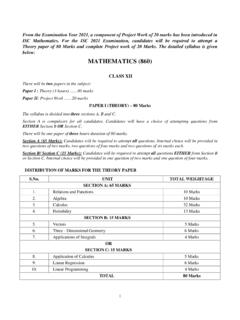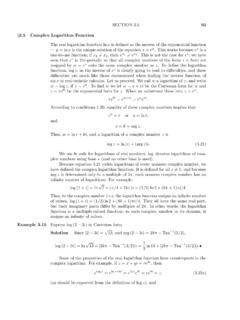Transcription of Derivatives Cheat Sheet - University of Connecticut
1 Derivatives Cheat SheetDerivative Rules1. Constant Rule:ddx(c) = 0,wherecis a constant2. Power Rule:ddx(xn) =nxn 13. Product Rule:(fg) =f g+fg 4. Quotient Rule:(fg) =f g fg g25. Chain Rule:(f(g(x)) =f (g(x))g (x)Common DerivativesTrigonometric Functionsddx(sinx) = cosxddx(cosx) = sinxddx(tanx) = sec2xddx(secx) = secxtanxddx(cscx) = cscxcotxddx(cotx) = csc2xInverse Trigonometric Functionsddx(sin 1x) =1 1 x2ddx(cos 1x) = 1 1 x2ddx(tan 1x) =11 +x2 exponential & logarithmic Functionsddx(ax) =axln(a)ddx(ex) =exddx(loga(x)) =1xln(a)ddx(ln(x)) =1x1 Chain RuleIn the below,u=f(x)is a function ofx. These rules are all generalizations of the above rules using thechain (un) =nun (au) =auln(a) (eu) = (loga(u)) =1xln(u) (ln(u)) = (sin(u)) = cos(u) (cos(u)) = sin(u) (tan(u)) = sec2(u) idea for all other trig (tan 1(u)) =11 + idea for all other inverse trig functionsImplicit DifferentiationUse whenever you need to take the derivative of a function that isimplicitlydefined (not solved fory).)
2 Examples of implicit functions:ln(y) =x2,x3+y2= 5,6xy= 6x+ 2y2, Differentiation Steps:1. Differentiate both sides of the equation with respect to x 2. When taking the derivative of any term that has a y in it multiply the term byy (ordy/dx)3. Solve fory When finding the second derivativey , remember to replace anyy terms in your final answer with theequation fory you already found. In other words, your final answer shouldnothave anyy terms in DifferentiationTwo cases when this method is used: Use whenever you can take advantage of log laws to make a hard problem easier Examples:(x3+x) cosxx2+ 1,ln(x2+ 1) cos(x) tan 1(x), etc.
3 Note that in the above examples, log differentiation isnot requiredbut makes taking thederivative easier (allows you to avoid using multiple product and quotient rules) Use whenever you are trying to differentiateddx(f(x)g(x)) Examples:xx,x x,(x2+ 1)x, etc. Note that in the above examples, log differentiation isrequired. There is no other way to takethese Differentiation Steps:1. Take thelnof both sides2. Simplify the problem using log laws3. Take the derivative of both sides (implicit differentiation)4. Solve fory 3








